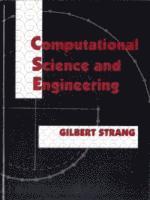
- Format
- Inbunden (Hardback)
- Språk
- Engelska
- Antal sidor
- 750
- Utgivningsdatum
- 2007-11-01
- Förlag
- Wellesley-Cambridge Press
- Illustrationer
- illustrations
- Dimensioner
- 285 x 222 x 12 mm
- Vikt
- Antal komponenter
- 1
- ISBN
- 9780961408817
- 1458 g
Computational Science and Engineering
Manual for Instructors
- Skickas från oss inom 7-10 vardagar.
- Fri frakt över 249 kr för privatkunder i Sverige.
Passar bra ihop
De som köpt den här boken har ofta också köpt Meriam's Engineering Mechanics av James L Meriam, L G Kraige, J N Bolton (häftad).
Köp båda 2 för 1780 krKundrecensioner
Fler böcker av Gilbert Strang
-
Linear Algebra and Learning from Data
Gilbert Strang
-
Introduction to Linear Algebra
Gilbert Strang
-
Wavelets and Filter Banks
Gilbert Strang
-
Algorithms for Global Positioning
Gilbert Strang
Recensioner i media
'Gil Strang has given the discipline of computational science and engineering its first testament in this new and comprehensive book. It surely extends Gil's long tradition of practical, wide-ranging, and insightful books that are invaluable for students, teachers, and researchers alike. If you could have only one book on a desert island, this might be it.' William Briggs, Professor of Mathematics at University of Colorado at Denver, and SIAM Vice-President for Education
Övrig information
Gilbert Strang received his Ph.D. from UCLA and since then he has taught at MIT. He has been a Sloan Fellow and a Fairchild Scholar and is a Fellow of the American Academy of Arts and Sciences. He is a Professor of Mathematics at MIT and an Honorary Fellow of Balliol College. Professor Strang has published eight textbooks. He received the von Neumann Medal of the US Association for Computational Mechanics, and the Henrici Prize for applied analysis. The first Su Buchin Prize from the International Congress of Industrial and Applied Mathematics, and the Haimo Prize from the Mathematical Association of America, were awarded for his contributions to teaching around the world.
Innehållsförteckning
1. Applied Linear Algebra: 1.1 Four special matrices; 1.2 Differences, derivatives, and boundary conditions; 1.3 Elimination leads to K = LDL^T; 1.4 Inverses and delta functions; 1.5 Eigenvalues and eigenvectors; 1.6 Positive definite matrices; 1.7 Numerical linear algebra: LU, QR, SVD; 1.8 Best basis from the SVD; 2. A Framework for Applied Mathematics: 2.1 Equilibrium and the stiffness matrix; 2.2 Oscillation by Newton's law; 2.3 Least squares for rectangular matrices; 2.4 Graph models and Kirchhoff's laws; 2.5 Networks and transfer functions; 2.6 Nonlinear problems; 2.7 Structures in equilibrium; 2.8 Covariances and recursive least squares; 2.9 Graph cuts and gene clustering; 3. Boundary Value Problems: 3.1 Differential equations of equilibrium; 3.2 Cubic splines and fourth order equations; 3.3 Gradient and divergence; 3.4 Laplace's equation; 3.5 Finite differences and fast Poisson solvers; 3.6 The finite element method; 3.7 Elasticity and solid mechanics; 4. Fourier Series and Integrals: 4.1 Fourier series for periodic functions; 4.2 Chebyshev, Legendre, and Bessel; 4.3 The discrete Fourier transform and the FFT; 4.4 Convolution and signal processing; 4.5 Fourier integrals; 4.6 Deconvolution and integral equations; 4.7 Wavelets and signal processing; 5. Analytic Functions: 5.1 Taylor series and complex integration; 5.2 Famous functions and great theorems; 5.3 The Laplace transform and z-transform; 5.4 Spectral methods of exponential accuracy; 6. Initial Value Problems: 6.1 Introduction; 6.2 Finite difference methods for ODEs; 6.3 Accuracy and stability for u_t = c u_x; 6.4 The wave equation and staggered leapfrog; 6.5 Diffusion, convection, and finance; 6.6 Nonlinear flow and conservation laws; 6.7 Fluid mechanics and Navier-Stokes; 6.8 Level sets and fast marching; 7. Solving Large Systems: 7.1 Elimination with reordering; 7.2 Iterative methods; 7.3 Multigrid methods; 7.4 Conjugate gradients and Krylov subspaces; 8. Optimization and Minimum Principles: 8.1 Two fundamental examples; 8.2 Regularized least squares; 8.3 Calculus of variations; 8.4 Errors in projections and eigenvalues; 8.5 The Saddle Point Stokes problem; 8.6 Linear programming and duality; 8.7 Adjoint methods in design.
Du kanske gillar
-
Earth
Stephen Marshak
Häftad -
Calculus
Robert A Adams
Inbunden


